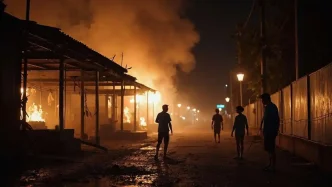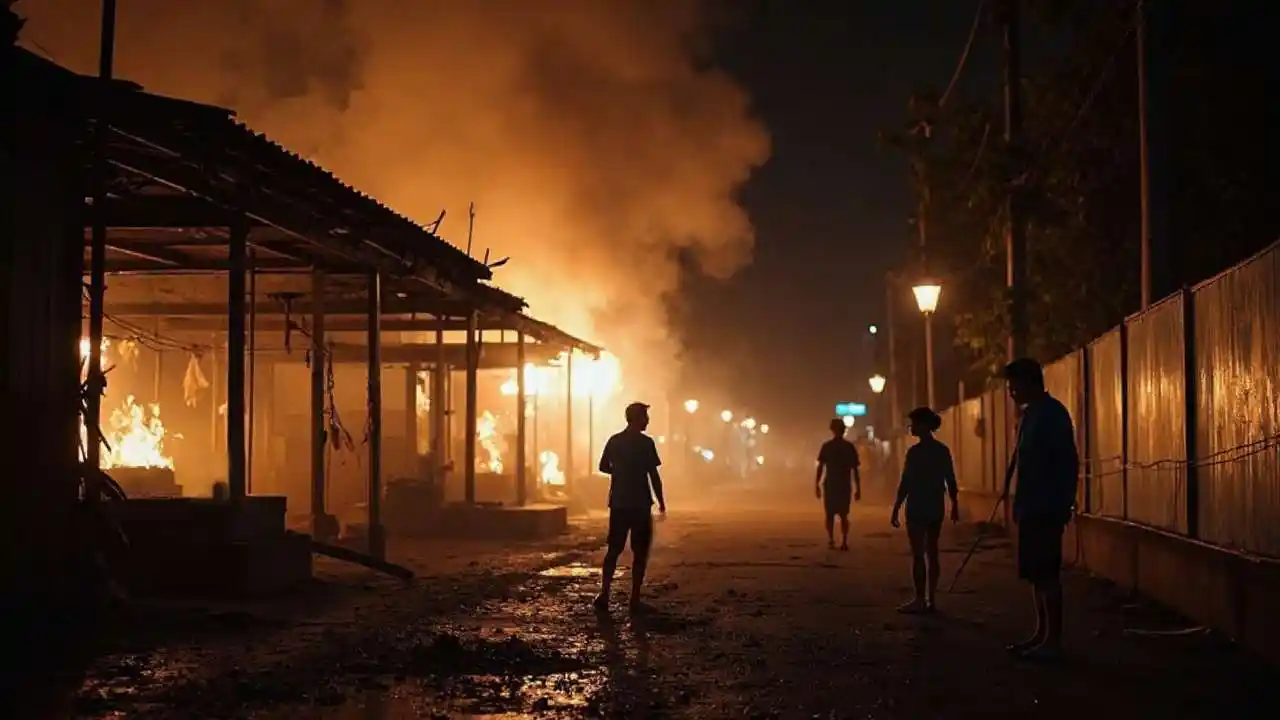Rahimah stands in the ruins of her Narathiwat home, the acrid smell of ash still lingering months after she says Thai soldiers set it ablaze. “They came in February, accusing us of hiding insurgents,” the 40-year-old mother says, her eyes fixed on a charred beam. “They burned our house, our fields—everything. We’re sleeping under tarps now.” Her story, shared during field investigations in Thailand’s Deep South, is one of dozens from Pattani, Yala, Narathiwat, and Songkhla, where locals claim the military torched homes and land in early 2025 to root out separatists. These unverified accounts echo allegations from two decades ago, when villages burned amid a brutal insurgency that has scarred this region for over a century.
The Deep South, home to 2 million Malay-Muslims who make up 80% of the population, is a land apart from Buddhist-majority Thailand. For decades, groups like the Barisan Revolusi Nasional (BRN) have fought for autonomy, driven by cultural erasure and economic neglect. Recent violence—18 attacks since mid-April 2025, including a bombing that killed three—has bloodied the region. Yet locals insist this is no new war, but a continuation of a conflict that has claimed over 7,000 lives since 2004. From historical claims of military arson to fresh wounds in 2025, this is a story of loss, defiance, and a region caught in a relentless cycle.
A History Written in Smoke
The roots of the insurgency lie in 1902, when Siam annexed the Pattani Sultanate, a Malay-Muslim kingdom tied to modern-day Malaysia. Thai policies—enforcing the Thai language and Buddhist norms—clashed with local identity, sowing rebellion. By the 1960s, separatist groups like the BRN emerged, demanding self-rule. A 1975 government memo, seen by this outlet, warned of “cultural erasure” and poverty fueling unrest. Today, the Deep South’s per capita income is ฿65,000 ($1,900 USD), half the national average, with unemployment at 12% against Thailand’s 3%.
The conflict’s modern phase erupted in 2004, when insurgents raided a Narathiwat army post, stealing 400 weapons and killing four soldiers. Since then, over 7,000 have died—soldiers, civilians, and 180 teachers targeted as symbols of Thai authority. In those early years, allegations of military abuses surfaced. In 2005, Human Rights Watch reported villagers in Pattani claiming soldiers burned homes after a bombing, accusing them of aiding militants. “They torched our village to scare us,” a 2006 Yala resident said. A 2007 Amnesty International report cited similar claims in Narathiwat, though no soldiers were prosecuted. A 2015 NGO report noted “property destruction” during raids, and in 2020, locals whispered of burned fields to disrupt insurgent supplies. “No one investigates,” a 2008 Pattani elder said. These unprosecuted claims, rooted in fear of reprisals, have left a legacy of distrust.
Chart: Breakdown of fatalities by victim group, 2004–2025
Efforts to broker peace have stumbled. Malaysia has facilitated talks since 2013, but they’ve yielded little. A 2020 Ramadan ceasefire collapsed over prisoner disputes. A 2024 negotiation draft, obtained by this outlet, shows Bangkok offering jobs but rejecting Malay-language education or autonomy. “They want surrender, not peace,” a BRN negotiator said, speaking anonymously. The 2023 election briefly raised hopes, with the Move Forward Party’s decentralization pledges winning votes in the South. Its 2024 dissolution by Thailand’s conservative elite crushed those dreams. “We voted for change,” said Ismail, a 55-year-old Yala imam. “Now kids are joining the BRN.”
A Restless Region
The year before 2025 saw violence flare, consistent with the 400 annual attacks from 2010–2021. On May 12, 2024, a bomb in Yala’s Bannang Sata district killed two and injured seven, timed to disrupt election campaigns. In August, insurgents hit a Narathiwat checkpoint, killing three soldiers with advanced IEDs. In January 2025, a Pattani teacher, accused of collaborating, was shot dead. “We’re keeping pressure on Bangkok,” said a former BRN operative, speaking anonymously. The BRN was testing tactics, like remote-detonated bombs, for a bigger strike.
In early 2025, allegations of military abuses resurfaced. During field investigations, residents in Pattani and Narathiwat claimed soldiers burned homes and fields in February and March, targeting villages suspected of insurgent ties. “They came at night, poured fuel, and burned our house,” said a 45-year-old Narathiwat farmer. “Our rice fields are gone.” In Pattani, a mother said, “Our village was ash by March. The army left us nothing.” These unverified claims, echoing 2005–2007 reports, suggest a pattern of retaliation. “We’re too scared to report it,” said a Yala elder. The 2004 Tak Bai massacre, where 85 protesters died in custody, lends weight to their stories.
In March 2025, tensions spiked. A leaked military memo proposed doubling troops, seen as provocative. On March 20, a failed BRN attack on a Songkhla police post hinted at larger plans, prompting heightened Songkran security. On April 15, the insurgents struck. At 6:45 AM, a car bomb ripped through a Pattani police station, killing five officers and injuring twelve. Hours later, attacks hit a Yala marketplace, killing eight civilians; a Narathiwat government office, claiming four lives; and a Songkhla power station, causing blackouts. The assaults, using remote-detonated IEDs, caused ฿150 million ($4.5 million USD) in damages. Thai officials point to the BRN. “Those detonators needed expertise,” said an Internal Security Operations Command source.
Locals see no break from the past. “It’s terrible, but it’s our life,” said Rahim, a 50-year-old Pattani shopkeeper. The 27 deaths recall 2012’s Yala bombing (14 dead, 130 injured). Some call the “escalation” label a pretext for crackdowns. “They want more troops,” said a Yala elder. The military’s response—2,000 soldiers, curfews, checkpoints—has deepened fears, especially amid claims of burned villages. Since April 16, 18 attacks have struck. On April 24, insurgents in Songkhla’s Sabayoi district killed Pongkorn Chumapan, a 16-year-old Buddhist, and wounded Pokanit Morasin, 12. On April 30, a Narathiwat roadside bomb killed two soldiers. On May 8, a Narathiwat district office bombing killed three, prompting a Malaysian travel warning. With 12 deaths and 25 injuries, these mirror past violence—2019’s Yala shooting killed 15; 2011’s Narathiwat bombing injured 118. “This isn’t new,” said a former BRN operative. “It’s the same fight.”
Chart: Fatalities from April 15, 2025, attacks by province
The BRN operates as a decentralized web, with cells across the Deep South and Malaysia’s border. “We’re recruiting tech-savvy kids—drones, encrypted apps,” said a defector. The April 15 attack’s IEDs suggest black-market support, though no state actors are implicated. A 2024 report estimates the BRN’s revenue at $2–3 million yearly from extortion and smuggling. “Businesses pay to survive,” said a Narathiwat merchant. Bangkok’s response leans on force. “We’re protecting order,” said an ISOC official. But locals say tactics like alleged burnings fuel the fire. “Raids make rebels,” said a Yala imam.
The Real Cost is Qualified by Loss
In Yala, Fatimah, a 38-year-old vendor, clutches the remnants of her life in a plastic sack, her market stall, a shattered heart of a bomb that killed eight on April 15, 2025. “The insurgents took my livelihood,” she says, her voice heavy with exhaustion. “Then soldiers came, burned our fields, saying we helped the rebels. Now my land’s ash.” Fatimah’s story is a chorus of grief echoing across the Deep South, where the conflict’s toll is measured not just in lives—over 7,000 since 2004—but in lives unmade. Schools have become battlegrounds, their chalkboards silent; 180 teachers have been gunned down since 2004, branded as Thai state enforcers. In Narathiwat, a principal named Yusuf begins each day checking desks for bombs, his hands shaking as he lifts each lid. “I teach math,” he says, his eyes hollow, “but my students learn fear first.” A local NGO in Pattani reports a 30% surge in domestic violence since April, tied to the grinding poverty and despair that shadow every attack, every burned home. “The war doesn’t just kill,” says Noor, a social worker. “It breaks families apart, stitch by stitch.”
The human cost seeps into every corner of life. In Pattani, a mother named Amina, watches her 15-year-old son, Amir, with dread. “The BRN offered him money to fight,” she says, her voice barely audible above the hum of cicadas. “He’s a boy, but they see a soldier. What future do we have here?” The insurgency preys on the young, exploiting a region where unemployment festers at 12% and dreams are rationed. Fatimah, too, sees no path forward. “I sell scraps now, under a tarp,” she says, gesturing to a pile of scavenged goods. “My daughter wanted to be a nurse. Now she just wants to eat.” These stories, raw and unfiltered, reveal a deeper wound: a society fraying under the weight of violence and neglect, where the alleged burnings—unverified but chillingly plausible given the 2005–2007 reports of torched villages—have turned communities into collateral damage.
Chart: Social impacts of the insurgency, including teacher deaths and estimated domestic violence deaths, 2004–2025
The conflict’s persistence ripples beyond the Deep South, straining Thailand’s border with Malaysia, where smugglers slip through a porous 650-km frontier, ferrying weapons and drugs to fuel the BRN’s war chest, estimated at $2–3 million a yearly by a 2024 security report. A 2025 UN report raises the specter of foreign jihadists eyeing the region, though no evidence has surfaced, a warning that hangs like smoke over an already tense border. The U.S. and Australia have offered technical aid—drones, training—but Bangkok bristles at the idea, wary of international eyes prying into allegations of military arson, like those in your 2025 findings or the 2004 Tak Bai massacre’s enduring shadow. Yet the region’s people demand more than warnings. A 2023 survey found 68% of Malay-Muslims citing cultural suppression as a core grievance, yearning for Malay-language schools to reclaim their identity. “They don’t want us,” says Ismail, the Yala imam, his voice thick with resolve. “But we’re still here, still speaking.”
Chart: Economic disparities fueling unrest in Southern Thailand, 2024
Some see glimmers of a path forward, though they’re faint against the conflict’s glare. Economic investment—vocational programs, roads, markets—could chip away at the 12% unemployment that feeds the BRN. In Narathiwat, a 2022 pilot trained 200 youths in tech repair, cutting local recruitment by 15%, per an NGO. Security reforms, like those in Aceh, Indonesia, where community policing eased tensions, could curb abuses, but only if allegations like the 2025 burnings are probed—independently, perhaps under UN oversight, as locals urge. “We need to trust again,” says Noor, her hands clasped tightly. “But trust is hard when your home is gone.” Others call for revived talks, not just Bangkok’s offer of jobs but a real reckoning: autonomy discussions, cultural respect, prisoner releases. Malaysia’s mediation falters, locals say, without global leverage. “The world watches us bleed,” says a Pattani elder, his eyes on the horizon, where the scars of war burn on.















